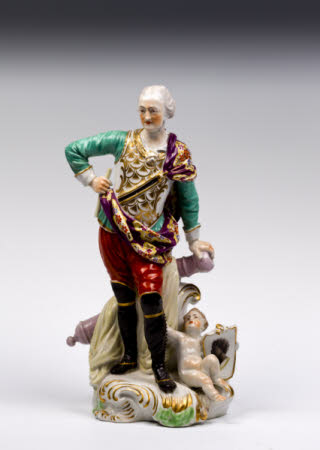General Conway
Chelsea Porcelain Factory (1744-1769)
Category
Ceramics
Date
circa 1765
Materials
Soft paste porcelain, enamel, gilding
Measurements
330 mm (Height)
Place of origin
Chelsea
Order this imageCollection
Upton House, Warwickshire
NT 446209
Summary
A figure of Field Marshal Sir Henry Seymour Conway (1721-95), of soft-paste porcelain, painted with enamels and gilded, Chelsea-Derby, circa 1765. In gilt cuirass, turquoise tunic, teracotta breeches and boots. A baton in his right hand, his left resting on a trophy of flags, cannon etc., beside which is a Cupid seated holding a shield emblazoned with the crest of Conway 'the bust of a Moor, face in profile, couped, proper, wreathed about the temples'. On a moulded Rococo scrollwork base.
Full description
General (later Field Marshal) the Hon. Henry Seymour Conway (1721-1795) was a British general and statesmen. As a senior Whig, he opposed the King's legal actions against the reformist John Wilkes in 1763, and this figure is thought to have been made as a companion piece to another of John Wilkes (NT 446210). Note on Heraldry: The head of a black person – sometimes crowned, sometimes ‘wreathed’ about the head – appears frequently as a motif (or charge) in medieval European heraldry. In the language of heraldry, the person depicted is described (or blazoned) as a ‘maure’, ‘moor’, ‘blackmoor’ or ‘blackamoor’, and the motif as ‘a maure’s head’ or ‘a moor’s head’, and so on. The term ‘maure’ derives from the Greek work ‘mauros’ meaning ‘black’ or ‘very dark’ and, in the medieval and early modern periods, was an ill-defined stereotype applied to Muslims of the Islamic Iberian Peninsula and North Africa. Usage developed to conflate Muslims of any ethnicity with black Sub-Saharan Africans. The image of the ‘moor’ or ‘blackamoor’ in European heraldry is itself usually stereotyped. Precisely when and where this motif was adopted as an heraldic charge is unknown, but the earliest example is thought to date from 11th century Italy. Its origins may lie in the invasion of Spain and Portugal in 711 by Africa and Arab Muslim forces. In Western Europe, the device may have referred to the black Egyptian St. Maurice, the patron saint of the Holy Roman Empire from the beginning of the 10th century, or to denote participation in the Crusades. Sometimes, in England, the device is used in what are known as ‘canting’ arms, and are incorporated into the arms of a family called ‘More’ or ‘More’, as a pun on their name. Several National Trust properties were, at one time in their history, owned by families whose coats of arms and/or crests incorporated ‘a moor’s head’ as an heraldic charge, and so it appears on objects which survive in National Trust collections. The arms of the Bankes family of Kingston Lacy, for instance, granted in 1613, included the crest ‘a moor’s head, full-faced, couped at the shoulders proper, on the head a cap of maintenance gules, turned up ermine, adorned with a crescent, issuant therefrom a fleur-de-lis or’. ‘Moors’ heads’ also featured in the arms of the Watt family, slave-traders and owners of several Jamaican plantations, who bought Speke Hall in 1795 and who set up their arms in stained glass in one of the windows there. The term ‘moor’ is now considered anachronistic, but it remains part of heraldry’s descriptive vocabulary. It is used here in its historical and heraldic context.
Makers and roles
Chelsea Porcelain Factory (1744-1769), maker
